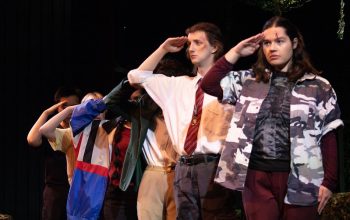Photo Credit: Green Chameleon on Unsplash
In conversation with some of the city’s creatives
Sana Mohsin, Arts and Lifestyle Editor
Grace Ma, Editor-in-Chief of The Trinity Review
I sometimes wonder, when does the writing process for a poem begin? Is it when you find yourself repeating a phrase that sparks in your mind? Or when you become interested in a new poetic technique taught in class? Or immediately after you finish writing your previous poem? The most obvious (and poetic) answer would be to declare it begins at all those times, and at all times. And the gift of poetry is that inspiration is abundant, as life is abundant: the blue morning sky, the glance you share with a friend, the smell of melting snow, a kiss on the cheek by the fruit aisle. Once I do begin writing, it is a process I sense I have little control over: what wants to be written seems to already have made itself clear (and it is sometimes good, often dull). After I finish this first draft, always with a pen in my notebook, I make pen-scratch edits, let the poem simmer for a bit, then transcribe it onto a Google Doc (taking liberty with minor edits as I type), let it simmer some more, and revisit it when I have the urge or time. I think this type of “spontaneous” creative process can be advantageous in its time efficiency and authentic appeal, and it can be disadvantageous for relying on learned, already-familiar poetic structure and idiosyncratic tendencies of craft. Of course, the advantages can be seen as disadvantages, and vice versa. Improving my advantages and disadvantages have come in many shapes and forms: reading more poems, editing others’ poems, participating in writing workshops, enrolling in creative writing courses, conversing with friends … Perhaps this sounds like I have expended a lot of time on my craft, but I think I have expended little, given all the wonderful realities that experiencing poetry gifts a person. Therefore, it looks like there is only one prospective solution to this insatiability: to make poetry a way of life!
Isabela Quito Villanoy, Associate Arts Editor of The Mike
As a content writer for both an online organization and for various publications, my writing process is constantly evolving and is never tied to a singular way or method. Regardless of the medium, I always start the process by brainstorming. For me, this is the most important and crucial part of your writing process. During this stage, I’m usually exploring ideas by reading articles or books, watching YouTube videos, browsing through creative illustrations, graphic design work, and the like, as a way to stimulate my creative juices. Seeking inspiration from artists and writers is a great way to begin the writing process because it motivates you to create connections and meaning — an important writing skill that is harnessed and enhanced through exposure. I often jot down notes, phrases, or words that jump out to me during the exploration stage — creating random doodles or art pieces can lead you to a potential theme or topic you want to write about. Once I’ve narrowed down a topic, I often ask myself three questions: First, what does the world need to know? Second, why am I writing about this? Lastly, what do I want to learn or realize from my own writing? I believe that reflecting on your what and why will make the entire writing process effortless.
If I were to give my old self writing tips, I’d only tell her one thing: be the better version of your previous self. Because writing is an art form, I have the tendency to compare myself with other writers. Believe me, it’s a very unhealthy and unproductive habit. Do your best to be better than your previous self. How do you become better than your previous self? Write in a journal, type on your phone, or your laptop. It doesn’t need to make sense. Write. Write. Write.
Eva Wissting, Deputy Editor of The Hart House Review
I’ve been working this year on a poetry collection for an independent study that’s based on my feeling of connection and disconnection with my home city, Stockholm, and this place where I currently live, Toronto. I zoom in on details, like the materiality of the pavement or how emotions are displayed or not displayed on public transit. When I write, I always need to start with a specific feeling that I want to convey. I’ve tried sometimes to start with something else, like a character, or a plot, or a setting, but it just turns flat for me. So, I’ve come to realize that for me, I need to start with a very specific feeling and then my next step is to decide what type of text I have to write to convey that feeling, whether a poem or a nonfiction piece, or flash fiction or something longer. I try to separate writing from editing. By far, I prefer the editing compared to producing new text. Getting the words out at first is almost painful, but once I have a bit to work with, trying different things with those words is just fun. But yeah, so I try to stick to just producing words at first, because otherwise I would never get anything new written. I think this varies a lot, though, for different people. Some writers prefer to draft a plan before they can start writing, while others can only discover the story as they write it. And for some, it works differently with each project. If you want to write, I think it’s important to try different approaches and be attentive and accepting to what you discover works for you. I like to read what different writers recommend, especially looking up what many different writers recommend, because then it becomes so clear that what works for one person doesn’t work for another. Also, writers are good at expressing themselves, so it’s usually entertaining reading. I read once about one writer, I don’t remember who, but anyway, she said she always had to have two writing projects. That way, she could actually get some writing done for one of them, while procrastinating the other. I think there’s a bit of truth in that for me.
Isabel Armiento, Editor-in-Chief of The Mike
I think one of the biggest mistakes starting writers make is thinking that they can get away with only writing one draft. If you want to put your best writing forward and create something cohesive and eloquent with logical flow, rhetoric consistency, and a compelling narrative, you will need to be prepared to write at least two full drafts, maybe even three or four. My writing process usually looks like several pages of research notes and draft paragraphs, then a rushed first draft, then more closely crafted second and third drafts, then several rounds of heavy editing, then two or three close copy edits. This is necessary for academic writing and journalism, and it’s also essential for fiction — but since fiction is so free-form and creative, you may be tempted to assume your first draft is a workable final product. It never is. I’m lucky enough to study at the University of Toronto, which is rich with writing resources. Creative writing courses of all kinds are offered through the English Department and the Creative Expression & Society and Writing & Rhetoric Minors; I would recommend INI311, “Seminar in Creative Writing,” for beginners — you will emerge with a portfolio of second-draft short fiction, and much more confidence than you started with. There are also plenty of on-campus workshops and panels about writing that are free for students — take advantage of these! Don’t underestimate the value of finding a writing community — when you finish a messy first draft, you’re going to need someone you trust to point out the gaps in logic, awkward wording, and boring sections — often the sentence you love most is the one that will make you cringe when you reread it in three months. Writing is hard, and when you finish a project (even if it isn’t your best work) remember to give yourself some serious self-love. You thought deeply, worked hard, and created something totally new, and you should be proud. Brag a bit — you’ve earned it.




